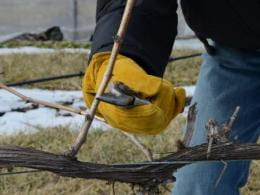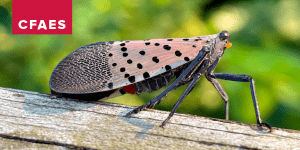OSU Extension county offices across the state are receiving e-mails and phone calls about Fall Armyworm (Spodoptera frugiperda, family Noctuidae) causing substantial injury to turfgrass. Thus far, it appears that fall armyworm is the dominant culprit rather than Yellowstriped Armyworm (S. ornithogalli) and Common Armyworm (Mythimna convecta).

Fall and yellow-striped armyworms are semi-tropical species that “fly” north each season. We often get both species in Ohio in August and September when they replace black cutworms that most superintendents see on their greens and tees. Both species also attack field crops, especially corn and small grains.

Every few years (usually 3-5 years), we get a massive buildup of these pests in the southern and transition turf zones. Reports of heavy armyworm activity have been coming out of Oklahoma to North Carolina for the last two months.
We believe adults from those outbreaks were picked up in the storm front that came from the south across much of Ohio about four weeks ago. The adults of these moths have been known to travel 500 miles, even more, in 24 hours. They can get into the jet stream and move vast distances, then drop down to find suitable host plants.

Adults tend to lay eggs on the flat leaves of trees and flowers that overhang turf, especially turf that has been recently fertilized. Each adult female can produce an egg mass that contains 100 to 500 eggs. The females are also attracted to night lights, and they will attach their egg masses to the light posts! If there are large areas where no plants or structures are overhanging the turf, the females will lay strips of eggs on grass blades.

The eggs hatch in 5-7 days and the larvae usually take three to four weeks to complete their 5-6 larval instars. The mature larvae dig into the thatch or upper soil and pupate without making a cocoon. The pupae take about two weeks to mature. So, the complete life cycle takes about 50-60 days.
Direct Control
Armyworms are so named because of their habit of moving en masse to greener pastures once they’ve depleted their food supply. It is not uncommon for the caterpillars to move from field crops into nearby turfgrass.


Once they move into turfgrass, the caterpillars will continue feeding until there is no more food or they complete their development, whichever comes first. If the plant food is exhausted, the armyworms will become meat-eaters with the larger caterpillars eating the smaller caterpillars to complete their development.

Turf that has had the canopy removed by the caterpillars will have the crowns and upper roots exposed to direct sunlight. The crown rests on the soil surface and is the growing point for both blades and roots. On sunny days, the area where the crowns are located can easily reach 120 to 130-degrees F which will “cook” them or dehydrate them. Loss of the crowns means the loss of the entire turfgrass plant; the turf is dead.

Thus, the first step in protecting the turfgrass plants is to kill the caterpillars before they completely devour the turfgrass canopy. This involves the direct application of insecticides.
Most turf managers are appearing to have success with their pyrethroid applications. However, we are getting reports from the agricultural markets that pyrethroids are not working well, so alternative chemistries should be considered.
Fall and yellowstriped armyworm populations often develop resistance to insecticide categories that are extensively used in the agricultural markets. Since our populations arrive from more southern regions, some moths may have arrived here in Ohio after their ancestors have been exposed to several applications of pyrethroids, carbamates, or organophosphates.
If you do not see a rapid kill of any fall armyworm population after the application of a pyrethroid, consider using an alternative. The diamides such as chlorantraniliprole (e.g., Acelepryn) or tetraniliprole (e.g., Tetrino) have excellent caterpillar-killing abilities. Both are registered for turfgrass usage and can be used at their lowest label rates for curative caterpillar control. Two combination products that contain a neonicotinoid plus a pyrethroid and seem to overcome any resistance are Aloft (clothianidin+bifenthrin) and Alucion (dinotefuran+bifenthrin).
Finally, azadirachtin-containing products are effective for control of all types of turfgrass-infesting caterpillars. Azatin O, Azaguard, and Neemex 4.5 are three such products and each is certified organic (OMRI). Note that Azatin XL is not registered for turfgrass use. These alternative insecticides are often difficult to find in over-the-counter outlets, but none are restricted-use insecticides (except for Aloft GC which is used on golf courses). Those that are not restricted use can be purchased by homeowners through internet vendors, but you will need the proper equipment to apply these commercial products.
Turfgrass Recovery
Turfgrass will recover with a little help from properly timed fertilizer applications if the insecticide applications were made quickly enough to protect a substantial percentage of the turfgrass canopy. However, if the canopy has been completely removed, the crowns need to be protected from dehydration through irrigation.

On golf courses, superintendents are used to syringing their greens and tees on such hot days as a method of cooling the turf crowns and keeping them hydrated. If possible, we also recommend watering damaged areas in the heat of the day to keep the crowns cooled down and hydrated. This should be kept up until a visible green cover returns to shade the crowns.
Home lawn recovery also involves watering to keep the crowns hydrated as well as fall fertilizer applications to support the regrowth of the blades. Fortunately, the first fall fertilizer application can be made right now. The fertilizer products should include a slow-release form of nitrogen to support turfgrass growth over a longer period.
If there is a concern that crowns are being lost, for example, if irrigation is not possible during high heat conditions, now is the time to look for grass seed as the supply of seed is down this year. However, here are a few points to consider.
While perennial ryegrass (Lolium perenne) will germinate quickly and provide rapid cover of damaged areas, we are also seeing a fair amount of grey leafspot which is killing perennial ryegrass. We recommend using a slit-seeder (= slice-seeder) to seed turf-type tall fescue (Festuca arundinacea). If possible, a blend of multiple cultivars should be used. The cultivars that have been developed in recent years have a color and texture that match Kentucky bluegrass (Poa pratensis).


Also, most turf-type tall fescues have endophytes that produce alkaloids that are toxic to armyworm and sod webworm caterpillars as well as other insects that feed on grass blades such as chinch bugs and billbugs. These seed products may have “endophyte-enhanced” on the bag or indicate the cultivars are resistant to insects.

NOTE: we do not recommend Kentucky 31 Tall Fescue (KY-31) for use in lawns. Although this was a naturally occurring variety found in Kentucky decades ago, it has very poor qualities for use as turfgrass. KY-31 is most suitable for soil stabilization such as along highways. It looks pretty good at 65 mph.
 Join us Saturday, March 18th at the Oasis Conference Center, 902 Loveland-Miamiville Rd, Loveland, OH 45140
Join us Saturday, March 18th at the Oasis Conference Center, 902 Loveland-Miamiville Rd, Loveland, OH 45140
 Please see the attached
Please see the attached 


 Six free, weekly webinars will focus on bumblebee biodiversity, ecology, and conservation. All sessions are on Fridays from 1 PM (Eastern Time) to 2:30 PM (Eastern Time) from March 18th to April 22nd.
Six free, weekly webinars will focus on bumblebee biodiversity, ecology, and conservation. All sessions are on Fridays from 1 PM (Eastern Time) to 2:30 PM (Eastern Time) from March 18th to April 22nd. Come join us for a three-part, online workshop to learn proper pruning techniques to improve production and quality in your apple, grape, and raspberry plantings. You will be online with Ohio State University South Centers experts, who will give live presentations with short pre-recorded videos. They will also answer your questions.
Come join us for a three-part, online workshop to learn proper pruning techniques to improve production and quality in your apple, grape, and raspberry plantings. You will be online with Ohio State University South Centers experts, who will give live presentations with short pre-recorded videos. They will also answer your questions. Registration is now open for the 2022 Ohio Woodland Water and Wildlife Conference. We will once again be live at the Mid- Ohio Conference Center in Mansfield. The program offers updates on spotted lanternfly and beech leaf disease and presentations on management for wild turkey, ticks and tick-borne pathogens, European frogbit id and control and streambank stabilization to name a few. The brochure for the day is attached
Registration is now open for the 2022 Ohio Woodland Water and Wildlife Conference. We will once again be live at the Mid- Ohio Conference Center in Mansfield. The program offers updates on spotted lanternfly and beech leaf disease and presentations on management for wild turkey, ticks and tick-borne pathogens, European frogbit id and control and streambank stabilization to name a few. The brochure for the day is attached OSU EXTENSION & HORTICULTURE AND CROP SCIENCES
OSU EXTENSION & HORTICULTURE AND CROP SCIENCES











